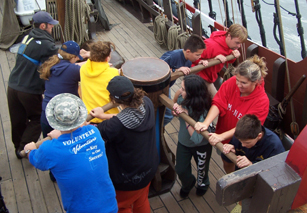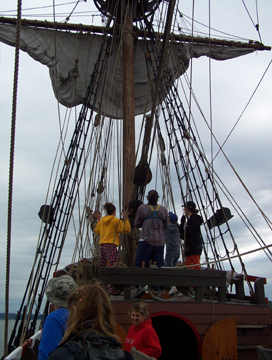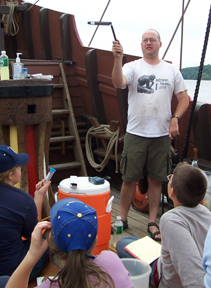 |
|
|

0630 hours
Current Position: Anchored off Beacon, NY.
Day Two of the second leg of our Voyage of Discovery.
Last night's weather was cool and pleasant, so a number of our students opted to sleep on the weather deck -- always a popular option.
|

0700 hours
As anchor watch comes to an end, the rest of the crew rises to greet their first full day on board the Half Moon. Overcast skies have rolled in overnight, but the upside is that we have a gusty, southerly wind to our backs. Today should provide some fine sailing.
|

0830 hours
After breakfast, the crew starts making preparations to weigh anchor. The below decks team is dispatched to safely stow everyone's gear and then wrap the anchor rode around the lower capstan and fake it in an orderly fashion.
|

0845 hours
Once we're ready for departure, we pause for our daily reading of Juet's journal.
|

0900 hours
The time has come! The crew moves into position to weigh anchor and be off. Kayley assumes her post as the communicator, relaying commands between the captain on the Quarter deck and the below decks team working in the orlop deck.
|

Down on the orlop, Kristian helps haul the rode back up to the bits after it winds around the capstan. As the rode reaches the bits, Michael and Katie fake it to leave it ready for use at a moment's notice.
|
 |
Mouse over to walk the capstan. |
Above decks, weather deck crew mans the capstan. By using this massive winch, all ten crew members you see here combine their strength, allowing us to raise the anchor (which weighs about 400 lbs., plus another 400 lbs. for the chain) without any modern mechanical assistance.
|

0915 hours
The anchor has been raised and secured on the fore channel. In the helm hutch, Mrs. Fountain assists Joli during her first shift at the helm.
|

0945 hours
With Sarah acting as lookout, we pass under the Newburgh-Beacon bridge and continue our journey upriver.
|

We continue to take salinity readings at regular intervals for the next few hours. Salinity levels continue to decrease with each reading.
|

1000 hours
We had a few spills here and there at breakfast, so we opt for a quick deck wash. It's too cool out for anyone to want to get sprayed with the hose, though.
|
 |
Mouse over to set the fore course. |
Today is such a fine day for sailing we can't help but want to set sail. We divide the crew into two mast teams -- fore mast and main mast -- and begin our sail handling training. Within a few minutes, we've set the fore and main courses and travel by wind power alone.
|

The students quickly pick it up and use the skills they learned yesterday -- coiling and belaying lines -- to good use.
Here, Santino is manning one of the main mast sheets -- a line that pulls the corner of the sail back toward the stern of the ship, helping the sail catch the wind.
|

1100 hours
When we take a sample just south of Wappinger's Creek, we find zero salinty: we've reached fresh water.
That marks the end of the crew's salinity project, but we'll be running more side projects during our time on the water.
|

It's also time to fly our Dutch colors. Up on the Quarter deck, Kayley helps Mr. Colley raise the Triple Crosses (the emblem of Amsterdam, the original Half Moon's home port) on our mizzen mast.
|

1130 hours
Mrs. Fountain gathers the students on the orlop deck to pass out disposable cameras.
|

The students can take pictures of anything they want during the voyage, all as part of Rensselaer Middle High School's snapshot project.
|

1200 hours
Sail handling continues above decks.

We need to make some adjustments to catch a shifting wind, so we need to belay the lines again after we've braced the sails.
|

1215 hours
The students' cameras are already being put to good use!
|

1230 hours
Lunch is served on the weather deck! We have a variety of wraps and salads to choose from today.
|

1300 hours
Erika has discovered that she really enjoys steering the ship. After relieving Kristian during his shift at helm so he can go eat, she decides to stay on the whipstaff for the rest of the hour. When Kayley comes on shift, Erika teaches her how to navigate.
|
As the shift changes, we're sailing past Poughkeepsie. Kristian uses our binoculars to study the shoreline.
|
1315 hours
 
Shipcraft training continues. Mr. Dawson and Mr. Colley rotate through small groups of students, teaching them the correct use of a safety harness. The students also learn the essential rule of maintaining three points of contact. A climber must maintain three points of contact (either one hand and both feet, or both hands and a foot) at all times to back themselves up in case of a slip.
|

1330 hours
On the orlop deck, our educators lead groups of students through one of their English Language Arts sessions. In a session earlier today, the students wrote out lists of words they associate with the ship. Now, they're drawing artistic renderings of those words in a freeform style -- including drawing with both hands and even drawing with their eyes shut. Tomorrow, we'll put the students' art on display.
|

The students who've gone through harness training now climb into the rig to take their hang tests. Once students pass the hang test, they're cleared to climb the rig and work aloft.
|

1530 hours
Dr. Jacobs, Mr. Bamberger, and the rest of the educator crew also work with groups of students throughout the day, introducing them to the experiments and instruments we'll be using over the next few days. Student project orientation is now well underway.
|

The students are becoming quite adept at sail handling, too.
|
 |
Mouse over to use the sling psychrometer. |
As part of the ongoing orientation sessions, Mr. Bamberger demonstrates the use of a sling psychrometer, which is used to measure humidity.
|

1645 hours
We've arrived at our destination for the day: Rondout Creek, at Kingston, NY, where the Hudson River Maritime Museum has generously offered to host us during our layover.
|

We immediately draw a crowd, including these prospective future student crew members. We'll be here at Kingston until midday Sunday, but the ship isn't open to the public. Likewise, with the exception of planned group expeditions, the students will remain on board throughout our stay.
|

Captain Reynolds and Mr. Hansen slip a fender in between the ship and the floating dock as we settle into our berth.
|

1715 hours
Sail handling is certainly done for the day, so several of the students who have completed harness training and the hang test go aloft to furl the sails. Taking time to enjoy the view from up top is on the roster as well.
|

Meanwhile, the students whose feet are still on deck pause to update their student journals and consider the presentation projects they'll want to start working on tomorrow.
|

1800 hours
Shiava volunteers to go aloft and help furl the main course.
|

With a little guidance from the senior crew, the main sail is soon bound with heavy rope gaskets, weatherproofing it against the rain we expect will reach us late tonight.
|

1830 hours
Once the main course is furled, Shiava and Ms. Wegman have certainly earned the chance to pause and relax in the main top.
|

Meanwhile, communal crew projects continue on deck. While docked here at Rondout Creek (and thus in a fixed location), we'll work as a crew to measure the water's depth and clarity. The students take turns going out onto the channel, where they learn how to use the lead line (to take soundings) and the Secchi disk (to measure clarity).
|

1900 hours
Dr. Jacobs also continues to meet with students, helping them select a presentation topic they find intriguing.
|

The sun is setting and the crew's getting hungry, so down come our climbers for the day. Wow! So that's where half the crew went!
|

1930 hours
As Ms. Wegman and her galley assistant transfer dinner to the weather deck, Captain Reynolds briefs the crew on our plans for the next few days. Although we aren't at anchor, we will maintain an anchor watch tonight, both to keep an eye on our mooring lines and to perform more communal weather observations. Tonight's anchor watch project is to measure barometric pressure as a storm front blows in.
|

Dinner's a hit. Ms. Wegman's key lime pie is particularly popular, with Captain Reynolds and Mr. Colley ultimately reduced to licking the bowl.
After dinner, the students meet with their educators on the orlop deck and decide on the experiments they'll perform once the data collection stage of their presentations begins tomorrow morning.
At 2200 hours, anchor watch begins and our day comes to an end.
|
|
On this date in 1609:
The fourteenth, in the morning being very faire weather, the wind South-east, we sayled up the River twelve leagues, and had five fathoms, and five fathoms and a quarter lesse; and came to a Streight between two Points, and had eight, nine, and ten fathoms: and it trended North-east by North, one league: and wee had twelve, thirteene and fourteene fathomes. The River is a mile broad: there is very high Land on both sides. Then wee went up North-west, a league and an halfe deepe water. Then North-east by North five miles; then North-west by North two leagues, and anchored. The Land grew very high and Mountainous. The River is full of fish.
-- Robert Juet's Journal.
|
| |
|
|
|